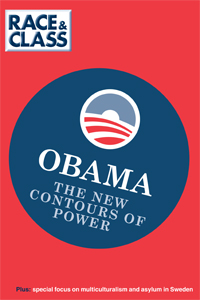Description
The April 2006 edition of the IRR journal Race & Class leads with an essay by Anis Shivani on a new literary ‘Orientalism’, continues with Graham Murray’s analysis of last year’s riots in the French banlieues and features articles on a new ‘ethnographic’ museum in Paris, the British Empire Exhibition of 1924 and the politics of the US Liberator magazine, 1929-1934.
Indo-Anglian fiction: the new Orientalism, by Anis Shivani
By aggressively promoting Indian-English writers like Amit Chaudhuri, Pankaj Mishra and Manil Suri, the conglomerate publishing industry is engaging in the commodification of an exoticised Orientalism. The stereotype of Indians promoted by such works is of paralysed, fatalist characters, at sea in a world of hyper-modernity. These novels reinforce westerners’ impression of an Indian subcontinent untouched by globalisation, feminism, capitalism and individualism. They serve as armchair tourism, resorting to fetishised symbols of Indian culture that the westerner feels at home in.
France: the riots and the Republic, by Graham Murray
The riots of November 2005 among Minority Ethnic youths in the banlieues of France exposed a racism that scores deep into the French nation. Emergency law was invoked, curfews imposed and thousands of police were deployed. In the process, both the riots and the response to them brought into the open an aspect of France’s secular republicanism that often lies hidden; an explosive mix of poverty, discrimination and Islamophobia. French assimilation is seen to have failed, yet the acceptance of multiculturalism as a social fact is viewed with suspicion.
Quai Branly museum: representing France after empire, by Sarah Amato
A major new museum is about to open in the heart of Paris. The favoured project of President Chirac, the core of its collection will be comprised of artefacts from Asia, the Americas, the Pacific region and Africa – all regions in which France once had colonies; it was preceded by a prestigious exhibition in the Louvre of sculptures from these regions. But is this an artistic venture, or an ethnographic one? And what does the project tell us about France’s understanding of, and relationship to, its colonial past?
Kenya, India and the British Empire Exhibition of 1924, by Deborah L Hughes
The British Empire Exhibition of 1924 was one of the last in a long series of imperial spectacles propagandising empire. But its rhetoric of racial unity and impartial governance was undermined by an attempted Indian boycott of the event. This was prompted by the British government’s unequal treatment of white and Indian settlers in Kenya. White settler privileges, already enormous, were further underscored, while Indian rights were restricted, segregation imposed and Indian immigration curtailed.
Race/class politics: the Liberator, 1929-1934, by Cathy Bergin
During the Depression years of the early 1930s, the American Communist Party attracted significant numbers of black activists, writers and workers to its ranks. The black-led Communist paper, the Liberator, was both the mouthpiece and rallying point for this movement. The type of race-class politics it forged was ground-breaking at the time, but it has been consistently misunderstood and misconstrued by later historians, often writing from a ‘cold war’ perspective.
Race & Class is published quarterly, in January, April, July and October, by Sage Publications for the Institute of Race Relations; individual subscriptions are £27/$47, for four issues, with an introductory rate of £20/$35 for new subscribers.
Related links
Race & Class: a journal on racism, empire and globalisation


